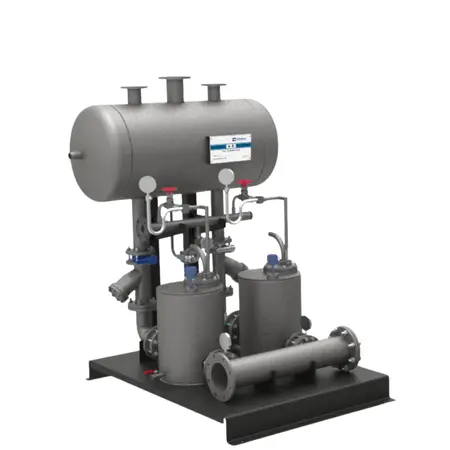Pressure Powered Pump Packaged Unit PPPPU
Condensate carries 12% of total energy in the steam generated and utilised. Without a proper recovery mechanism, this energy is bound to be wasted. In order to keep energy requirements to a minimum, it is important that condensate is handled efficiently and energy from the condensate is recovered and utilized for heating up the feedwater.
When it comes to pumping the condensate collected, centrifugal pumps prove to be highly limiting and costly. The Forbes Marshall Pressure Powered Pump Packaged Unit is designed to pump condensate without electricity, using just 3 kg of steam per ton of condensate. It can pump condensate at higher temperatures of 100 Deg C and more.
- PPPPU comes as a complete skid mounted package unit with receiver, motive steam line and check valve at outlet.
- Designed to Pump condensate at 100 Deg. C. plus temperatures for recovery of maximum energy.
- PPPPU has been tested for 1 million cycles of operation.
- Can work on steam as well as air and available in capacities to recover 50 to 50,000 kg/hr of condensate
Frequently Asked Questions
Mechanical or steam powered pumps perform much better when it comes to pumping hot condensate. First of all, cost of steam used by mechanical pumps is just a fraction of the cost of electricity required by electrical pumps. Electrical pumps cannot pump the condensate at 100 Deg. C. as it leads to cavitation in the pumps. As a result, when electrical pumps are used, the condensate needs to be cooled down which wastes the heat energy contained in it. On the other hand, the mechanical pump can pump condensate at 100 Deg. C.
An efficient condensate return system that includes steam traps, flash steam recovery units, and condensate pumps is the best way to collect and return condensate to the boiler, reducing water and energy costs.
A pressure powered pump uses an external pressure source, such as steam or compressed air, to move liquids or condensate through a system. It works by using pressure to displace liquid within a sealed chamber and direct it to the desired location, typically for transporting condensate in steam systems or other fluids in various industrial applications.
In Industry, a pressure powered pump is used to transport condensate in steam systems, especially from locations where gravity return isn’t feasible.
To select the correct pump size, determine the inlet motive pressure and the back pressure, which includes vertical lift, pressure in the return line, and any frictional losses. Use the capacity chart provided by Forbes Marshall to identify a pump that meets the required condensate load under the specific pressure conditions.
A pressure powered pump is the preferred choice for recovering condensate in industrial applications.
Yes, the Forbes Marshall Pressure Powered Packaged Pump can replace electric pumps in certain applications, especially in steam systems where electricity is unavailable or undesirable. It is ideal for handling condensate and other fluids in environments with access to steam or compressed air.




